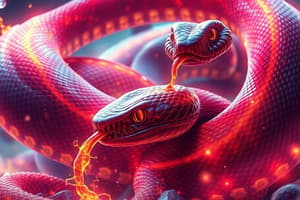Podcast
Questions and Answers
What is the primary function of the cysteine switch mechanism in snake venom metalloproteinases (SVMPs)?
What is the primary function of the cysteine switch mechanism in snake venom metalloproteinases (SVMPs)?
- To maintain SVMPs in an inactive state until activation (correct)
- To prevent the degradation of SVMPs
- To activate SVMPs by binding to metal ions
- To enhance the enzymatic activity of SVMPs
Snakes typically produce only one type of SVMP toxin
Snakes typically produce only one type of SVMP toxin
False (B)
What post-translational modifications are crucial for SVMP activity and facilitated by insect cell expression?
What post-translational modifications are crucial for SVMP activity and facilitated by insect cell expression?
Glycosylation
Activation of SVMPs occurs when ______ ions trigger the dissociation of the prodomain.
Activation of SVMPs occurs when ______ ions trigger the dissociation of the prodomain.
Match the SVMP class with its domain composition:
Match the SVMP class with its domain composition:
Why is fibrinogen used as an assay to test SVMP activity?
Why is fibrinogen used as an assay to test SVMP activity?
Anion exchange chromatography separates proteins based on their size.
Anion exchange chromatography separates proteins based on their size.
What is the purpose of adding glycerol to the final purified protein before freezing?
What is the purpose of adding glycerol to the final purified protein before freezing?
A zymogen band appearing after MP activation indicates ______ activation.
A zymogen band appearing after MP activation indicates ______ activation.
How does Immobilized Metal Affinity Chromatography (IMAC) facilitate protein purification?
How does Immobilized Metal Affinity Chromatography (IMAC) facilitate protein purification?
Flashcards
Cysteine switch mechanism
Cysteine switch mechanism
Keeps SVMPs inactive by bonding a cysteine residue and metal ion in the enzyme's active site.
SVMP toxins
SVMP toxins
Toxic components that contribute to necrosis, hemorrhage, and blood coagulation disorders by degrading extracellular matrix proteins.
Catalytic Domain
Catalytic Domain
Enzymatic region essential for SVMP's protein-degrading function, showing high conservation across different SVMPs.
Extra domains
Extra domains
Signup and view all the flashcards
Insect Cell Expression advantages
Insect Cell Expression advantages
Signup and view all the flashcards
Anion exchange chromatography
Anion exchange chromatography
Signup and view all the flashcards
Fibrinogen
Fibrinogen
Signup and view all the flashcards
Purpose of Zn2+
Purpose of Zn2+
Signup and view all the flashcards
His-tag role in purification
His-tag role in purification
Signup and view all the flashcards
Cryoprotectant
Cryoprotectant
Signup and view all the flashcards
Study Notes
- The cysteine switch mechanism inactivates snake venom metalloproteinases (SVMPs)
- Activation occurs when Zn2+ ions trigger the dissociation of the prodomain, exposing the active site, allowing protein degradation and contributing to venom toxicity
SVMP Toxins
- SVMPs are highly toxic components in snake venom that cause necrosis, hemorrhage, and blood coagulation disorders
- They degrade extracellular matrix proteins, causing bleeding, inflammation, and muscle damage
Diversity of SVMPs
- Snakes produce multiple SVMPs with varied structures and functions
- SVMPs are categorized into PI, PII, and PIII classes, differing in domain number and targeting different host proteins
Conservation Among SVMPs
- SVMPs exhibit moderate to high conservation, especially in the catalytic domain
- Domains like disintegrin-like and cysteine-rich domains are more variable, potentially evolving to target different host proteins
Role of Extra Domains in SVMPs
- PI SVMPs contain only a catalytic domain, sufficient for protein breakdown but lacking targeting functions
- PII and PIII SVMPs include disintegrin-like and cysteine-rich domains that enhance toxin interaction with host proteins
- The cysteine-rich domain affects substrate specificity and protein stability
- Extra domains increase efficiency in degrading fibrinogen and extracellular matrix proteins
Advantages of Insect Cell Expression
- Insect cells allow proper protein folding and post-translational modifications like glycosylation, crucial for SVMP activity
- Proper folding requires correct disulfide-bond formation, facilitated by insect cells
- Insect cells can handle complex proteins better than bacterial systems
- Insect cell expression reduces the risk of endotoxin contamination
Disadvantages of Insect Cell Expression
- Slower growth rate compared to bacteria, increasing time
- More expensive due to specialized media and equipment
- Lower protein yield because the secreted protein needs correct folding for proper activity
Alternative Expression Systems
- Bacterial expression (E. coli) is unsuitable due to its inability to perform post-translational modifications like glycosylation
- Mammalian cell expression is more expensive and complex than insect cells
- Yeast expression is an alternative, but it can result in undesirable hyperglycosylation
Anion Exchange Chromatography basics
- Separates proteins based on charge
- The column contains positively charged resins that bind negatively charged proteins
- Proteins are eluted by increasing salt concentration, which disrupts ionic interactions and releases proteins from the resin
- More negatively charged proteins elute later, and less charged proteins elute earlier
Zymogen Band on MP Activation
- Could be due to insufficient Zn2+activation or non-optimal concentration
- Contaminating inactive forms of zymogens may have misfolded and become resistant to activation, because the prodomain is inaccessible
Fibrinogen as an Assay
- Fibrinogen used because it is a key blood-clotting protein, linking degradation directly to hemorrhagic effects of SVMPs
- Many SVMPs target fibrinogen and fibrin, disrupting clot formation
- Fibrinogen is a well-established, quantifiable assay that provides clear evidence of SVMP activity
Alternative Assays
- Collagen degradation assay: measures the ability of SVMPs to break down connective tissue
- Plasma clotting assay: measures how SVMPs affect blood clot formation and breakdown
- Insulin B assay: The presence of active SVMP will break down the insulin B-chain, confirmed using SDS-PAGE gel
Insect Cells
- Insect cells facilitate proper protein folding and post-translational modifications, critical for SVMP activity
- Bacterial systems lack these capabilities, often leading to misfolded or inactive proteins
Steps to Construct SVMP expression
- MultiBac baculovirus/insect cell expression system was used
- Bacmid Preparation & Transfection: Genes added to DH10EMBacY E. coli, screened using blue/white selection, and transfected into Sf21 insect cells
- Amplification & Expression: Virus-containing cells harvested, and protein expression induced in Hi5 cells
- Purification: Proteins extracted and purified using Immobilized Metal Affinity Chromatography (IMAC), Anion Exchange Chromatography (AIEX), and Size Exclusion Chromatography (SEC)
Monitoring Protein Expression
- Monitored using Yellow Fluorescent Protein (YFP) analysis
- Daily samples were lysed, and fluorescence was measured at excitation 430 nm, emission 528 nm to determine protein production levels
Activation Step
- Zn2+ was used to activate SVMP by disrupting the cysteine switch, releasing the prodomain to convert the zymogen to an active form
- Different Zn2+ concentrations were tested for complete activation
Immobilized Metal Affinity Chromatography (IMAC)
- Separates proteins based on their histidine (His) tags binding to nickel (Ni2+)-charged resins
- Non-His-tagged contaminants are washed away
- The protein is eluted using imidazole, which competes with the His-tag for binding, allowing collection of the target protein
Anion Exchange Chromatography purpose
- Separates proteins based on their charge
- SVMP proteins, which are negatively charged, bind to the positively charged resin
- Proteins are eluted gradually by increasing salt concentration
SDS-PAGE purpose
- Used to confirm protein expression and purity throughout the experiment
- After expression: To check successful production of SVMP constructs
- After purification steps: To see if impurities were removed
- After activation: To ensure zymogen was properly converted into the mature enzyme
Fibrinogen Degradation Assay definition
- Tested the enzymatic activity of activated SVMP constructs
- Measured ability to degrade fibrinogen, a key blood-clotting protein
- More fibrinogen degradation indicates higher SVMP activity
EDTA and SVMP Activity
- EDTA chelates Zn2+ ions, essential for SVMP activity
- By inactivating SVMPs, EDTA serves as a negative control, confirming observed activity is due to the enzyme
Zymogen Band Significance
- Incomplete activation: Proteins may not have fully lost their prodomain
- Inefficient Zn2+ binding: Activation conditions may not have been optimal
- Protein aggregation: Some zymogens may have misfolded, preventing activation
His-Tag Function
- A His-tag was added to SVMP constructs for purification using Immobilized Metal Affinity Chromatography (IMAC)
- The histidine residues bind strongly to nickel (Ni2+)-charged resins
Protein Separation using IMAC
- Separates via metal ions (Ni2+) bound to a column resin
- His-tagged proteins bind to the column after loading the sample
- Unwanted proteins washed away with a low-imidazole buffer
- Target protein eluted by increasing imidazole, which competes with His-tags for binding
AIEX post IMAC
- IMAC alone can leave impurities
- AIEX was used for further purification separating proteins based on charge
- Since SVMPs are negatively charged, they bind to the positively charged resin
Chromatography pH
- Correct pH determined via the isoelectric point (pI) of the protein
- Chosen pH is usually 2-3 units higher
- If a pH(8) > pI (~5), the protein will be negatively charged
SEC usage
- SEC serves as a final polishing step to ensure the protein is in correct oligomeric state
- Separates proteins based on size using a gel filtration column
Chromatography Salt
- Salt (e.g., NaCl) competes with the protein for binding
Dialysis reason
- Dialysis was performed to exchange the buffer and remove excess imidazole
- The protein was placed in a membrane bag, submerged in buffer
Potential IMAC contaminants
- Partially expressed proteins with weak His-tags
- Nonspecifically bound proteins from insect cell lysate
- Protein degradation products
- AIEX removes these through charge
Impurity peak presence and chromatography
- Suggests presence of non-target proteins, degradation fragments, or aggregates
- Additional purification steps or different buffer conditions may be needed
Chromatography Cryoprotectant
- Glycerol added to prevent protein aggregation or denaturation during freezing
- Varied concentrations used based on construct stability
- MP/Dis/Crich construct → 9% glycerol
- MP/Dis construct → 7.5% glycerol
- MP construct → 5.5% glycerol
IMAC function
- IMAC pulls out all the media and concentrates the protein
- SEC requires lower amounts of volume (500ul)
- IMAC uses His-tags
SVMPs cryo-structures
- Solved for other PIII SVMPs but not for any Echis
- Ones that have been determined have the same three domains
Studying That Suits You
Use AI to generate personalized quizzes and flashcards to suit your learning preferences.




